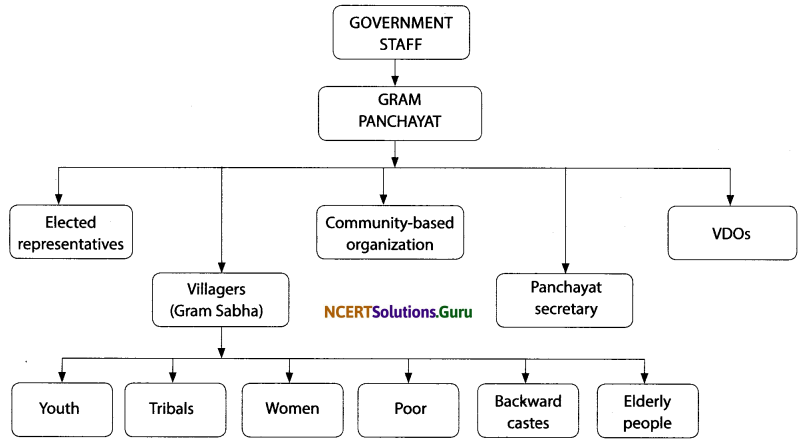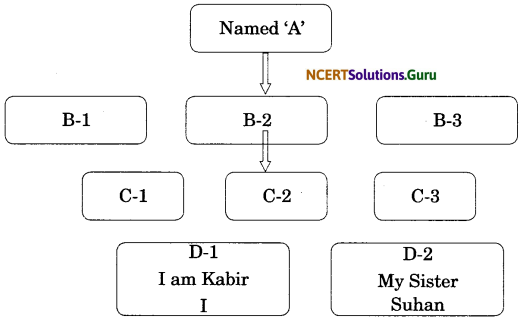Rural Administration Class 6 Questions and Answers Provided helps you to answer complex Questions too easily. You can use them while preparing for board exams and all of them are given by subject experts. Reading NCERT Solutions for Class 6 Social Science Civics Chapter 6 Rural Administration familiarizes you with the kind of questions appearing in the board exams. Students are advised to read these solutions on a regular basis to score well.
Rural Administration Class 6 Questions and Answers Civics Chapter 6
Make your learning experience enjoyable by preparing from the quick links available on this page. Use the Class 6 SST Civics Chapter 6 NCERT Solutions and get to know different concepts involved. All the Solutions are covered as per the latest syllabus guidelines. Knowing the NCERT Class 6 Civics Chapter 6 Questions and Answers helps students to attempt the exam with confidence.
Rural Administration NCERT Intext Questions and Answers
Question 1.
If there is any theft in your house which police station would you go to register your complaint?
Answer:
In this case, we would go in our area’s Police Station.
![]()
Question 2.
What was the dispute between Mohan and Raghu?
Answer:
There was a land dispute between Mohan and Raghu.
Question 3.
Why was Mohan worried about picking a quarrel with Raghu?
Answer:
Mohan was worried because Raghu’s family-owned many fields and besides his uncle was also the Sarpanch of the village.
Question 4.
Some people said Mohan should report the matter to the police and others said he should not. What were the arguments they gave?
Answer:
Mohan’s one friend suggested that they go to the local police station and file a report. Others were doubtful if this was a good idea because they felt they would waste a lot of money and nothing would come out of it. Some people said that Raghu’s family would have already contacted the police station.
Question 5.
Find out the term used for the Patwari in your state.
Answer:
Discuss with your teacher or parents and find out the another name for Patwari.
Question 6.
If you live in a rural area find out:
How many villages does the Patwari of your area maintain land records of?
How do people in the village contact him/her?
Answer:
Discuss with your teacher.
Class 6 Civics Chapter 6 NCERT Textbook Questions and Answers
Question 1.
What is the work of the police?
Answer:
The main work of the police is to enquire, to investigate and taken action on the cases such as theft, accident, injury, fight etc., within its area.
![]()
Question 2.
List two things that the work of a Patwari includes.
Answer:
The work of a Patwari includes:
- Maintenance of land records
- Collection of land revenue from the farmers.
Question 3.
What is the work of a tehsildar?
Answer:
The works of tehsildar are as under:
- He is the in-charge of Tehsil Revenue Agency and is responsible for proper preparation and maintenance of Tehsil Revenue Record and Revenue Accounts.
- He is also responsible for recovery of government dues under the various Acts.
He is supposed to have proper control over the working of Patwaris and other officials and for this purpose the Tehsildar and Naib Tehsildars make inspection of patwaris and other officials working under them.
Question 4.
What issue is the poem trying to raise? Do you think this is an important issue? Why?Answer:
In the poem ‘A daughter’s wish’, a girl is raising a very strong issue. This issue is concerning the property of father. In the poem it is described that her father got house from his father and this will go to her brother, but what will she and her mother receive? She says that she wants only a place of her own. She also does not accept silk and gold as a dowry. She wants justice and equality.
Question 5.
In what ways are the work of the Panchayat, that you read about in the previous chapter, and the work of the Patwari related to each other?
Answer:
The Panchayat finalizes development work of the area while a Patwari is responsible for maintaining the records of land, crops and collection of revenue from the farmers. Both are related to the villagers. Members of Panchayat are elected while Patwari is appointed by the government.
Question 6.
Visit a police station and find out the work that the police have to do to prevent crime and maintain law and order in their area especially during festivals, public meetings etc.
Answer:
Under the crime a long list of offences is included. Crimes can be committed against persons or property, but all crimes carry a punishment for those who break the law. Governments pass laws to establish what is acceptable behaviour and what is not acceptable behaviour within society. An illustrative list of crime is as under:
Serious bodily harm, burning of a building, land or property, unlawful physical contact with another person, bribery, burglary, child abuse, child pornography, computer crime, conspiracy to commit crime, credit card fraud, disorderly conduct, disturbing the peace, domestic violence, drug trafficking or distribution, drunk driving, embezzlement, extortion, forgery, fraud, harassment, hate crime, kidnapping, money laundering, murder, prejury, prostitution, public intoxication, rape, robbery, sexual assault, theft etc.
During festivals and public meetings, police have to make sufficient arrangements to maintain law and order position at the places. As a measure, policemen are deputed on the spot as per requirements, CCTV cameras are installed, an ambulance and a fire brigade vehicle are provided on the spot. Apart from this, some officials may also be deputed for close and hidden monitoring.
Question 7.
Who is in charge of all the police stations in a district? Find out.
Answer:
In-charge of all the police stations in a district is called Superintendent of Police (SP).
Question 8.
How do women benefit under the new law?
Answer:
According to the new law, “Hindu Succession Amendment Act, 2005” lands are divided equally among sons, daughters and their mother. The same law will apply to all states and union territories of the country. In case of any problem related to her livelihood; a daughter can always depend upon her share of the land. Thus, this law provides social security to the women.
![]()
Question 9.
In your neighbourhood are there women who own property? How did they acquire it?Answer:
The students discuss it with their teacher.
Hope the data shared above regarding the NCERT Class 6 Social Science Civics Chapter 6 Rural Administration PDF has aided in your exam preparation. If you ever need any assistance you can always reach us and our team will guide you at the soonest possibility.


